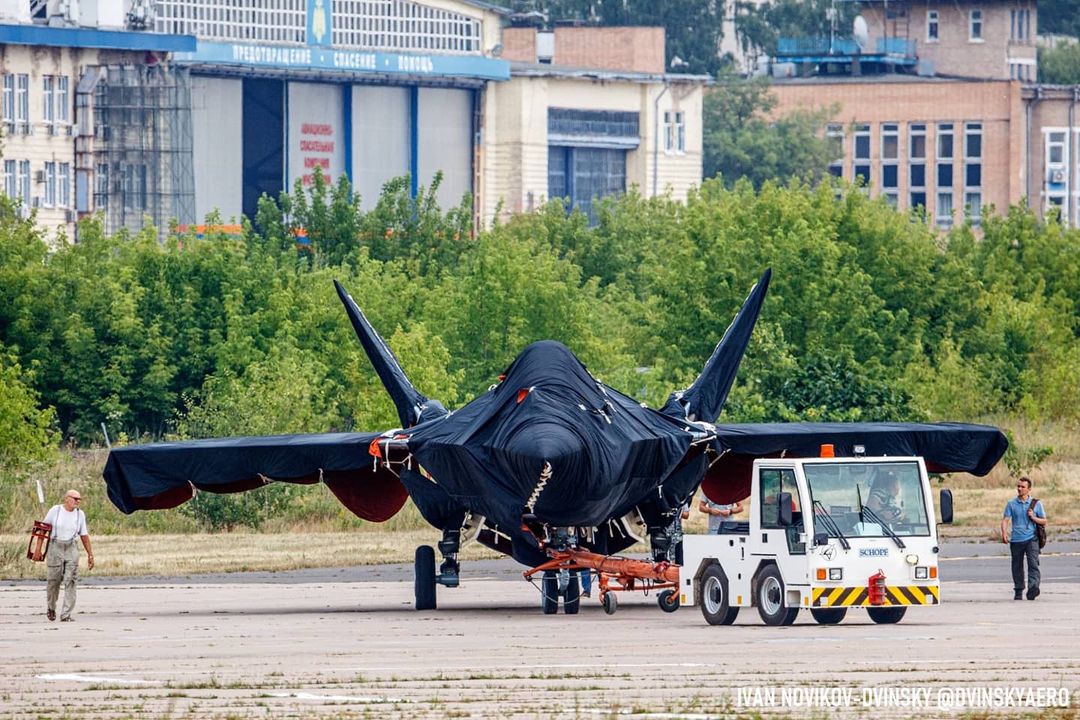First comments on new single-engine Russian fighter: Checkmate?
Teaser images may describe configuration of new light/medium-weight Sukhoi fighter

TASS has announced that Russia’s latest fighter aircraft will be unveiled, and, indeed, demonstrated, at the MAKS-2021 show on July 20. We consider what this might mean and what the configuration of the circulating images reveals.
The aircraft is reported to be Russia’s first single-engine low signature supersonic tactical fighter, and has been developed by Sukhoi. The stated intent is to ‘rival the US fifth-generation F-35 aircraft’. The aircraft is also described as a domestic light fighter which will compete with the F-35 in export markets.
The below image above is a ‘teaser’ for the aircraft and must be viewed with some caution until the actual hardware is revealed. The basic configuration shown in the illustration above has a near-diamond wing planform, with thin highly-tapered low-aspect-ratio wings, a forward canard, and twin butterfly tails. The aircraft has a single engine, with a large diverterless intake (UPDATE: the aircraft or mock-up photographed beneath a tarpaulin has shoulder mounted intakes similar to that of the F-22 and appears not to have a canard) under the forward fuselage. An Infra-red Seeker Tracker is located ahead of the cockpit, and a radar is mounted in the aircraft nose.


Given Sukhoi experience in the application of thrust vectoring to its heavy fighter designs, it would be surprising if this were not also fitted to the new aircraft.
The wing planform and tail design are somewhat reminiscent of the McDonnell MFVT (Mixed Flow Vectored Thrust) ASTOVL concept but the aircraft features a chin intake rather than side intakes. The Newark Air Museum in the UK have a model of that concept, shown below. The MFVT design was one of the propulsion alternatives examined in early UK-US joint technology studies looking at possible ASTOVL concepts in advance of the JSF programme.

What can we infer about the aircraft? To me, the highly-tapered, low aspect ratio wing suggests that the design is intended to be used for BVR combat, as the wing area and aspect ratio suggest sustained turn performance might not be a strong point. The fuselage below the wing line is rhomboidal, the flat sides and fuselage width suggesting reasonable size internal weapons bays, which are necessary if the aircraft is to have a low signature.
Whether a low signature is achieved will depend on a number of aspects – not just the shape, but the materials, the manufacturing standards, and the electromagnetic properties of the surfaces and structure. Certainly, some will question whether the canard foreplane and the large under-fuselage intake are compatible with this intent.
From the wording used in the press release – descriptors like ‘domestic light fighter’ and ‘tactical fighter’, and the reference to exporting the aircraft, it could be that the new Sukhoi is intended to be a cheap alternative to the F-35, suggesting, perhaps, that some compromises in the signature area might have been made in the interests of containing acquisition, operating and maintenance costs.
The Hush-Kit Book of Warplanes will feature the finest cuts from this site along with exclusive new articles, explosive photography and gorgeous bespoke illustrations. Pre-order The Hush-Kit Book of Warplanes here. Thank you. Our controversial merchandise shop is here and our Twitter account here @Hush_Kit. Sign up for our newsletter here. The Hush-Kit Book of Warplanes will feature the finest cuts from this site along with exclusive new articles, explosive photography and gorgeous bespoke illustrations. Pre-order The Hush-Kit Book of Warplanes here.

Could the aircraft indeed be a Russian equivalent to the @Hush_Kit F-36 Kingsnake concept, aiming to regain the position once achieved with the widespread use of the MiG-21 by undercutting the cost of the F-35?
– Jim Smith
Save the Hush-Kit blog. Our site is absolutely free. If you’ve enjoyed an article you can donate here. Your donations keep this going. Thank you.
Hush-Kit thoughts
It is hard to know what to make of Russian rumours or even official statements regarding military hardware, and this is a prime example. There are more unknowns than facts around this fighter. Is it single-engined? Is it primarily for export? Could there be a STOVL variant? Manned, unmanned* or (more absurdly) optionally manned? If built, would it be built by Sukhoi or MiG (some recent releases mention Sukhoi but many older ones mention MiG)? If it is for export, and a cheap stealthish fighter could be just the ticket, then a launch or partner nation will be sought. India is said to like their Russian-sourced MiG-29UPGs very much but was far from happy with its treatment in the Sukhoi/HAL Fifth Generation Fighter Aircraft (FGFA) project. Whether they would want another partnership after the mess of FGFA is open to question, though a later off-the-shelf purchase would seem a viable idea. So who could afford to invest in such a fighter? Even domestic orders are far from assured these days with the MiG-35 floundering in obscurity, the Su-57 flailing around in single digits while even the dominating ‘Flanker’ series is not being ordered in enormous numbers. Outsiders who would love a long range stealthy fighter-bomber include Iran and Argentina but both seem highly unlikely to get involved. China has its own Shenyang FC-31 kicking around (somewhere) which appears to be in the same category so Sino-Russian collaboration seems an unlikely bet. Though it has long enjoyed a partnership with Russia, China is now far richer and ahead technologically in almost every aspect of military aerospace so what it would gain from cooperation with an increasingly unpopular Russia is hard to see.
Another issue is that no-one (at least publicly) really knows what the next generation of fighters will look like – or even if their should be one. Following or countering the American lead, as has been historically the case, is harder now as there is uncertainty on which technological direction the US will go in. The UK, with a similar defence budget to Russia is also thinking big with its Tempest research project, but this appears to have the same vagueness of direction, with placeholder shapes and every conceivable tech being mentioned without a clear idea of what is needed or why.
Despite a defence budget less than a tenth that of the US, Russia still thinks big, but with a global GDP percentage that has shrunk by almost 1% since a high of 4% in 2007/8 it is often biting off more than it can chew. As with the US experience, so-called ‘5th Generation’ heavy fighters have proved budget vampires, with many seeing an obsession with brand new airframes as an archaic idea. Mentioned as a “new light plane designed to cope with tactical assignments” in the TASS press release it is seen as ‘Lo’ to the Su-57’s ‘Hi’. This is what the US F-35 was originally intended to be (to the F-22’s ‘Hi’) but spirally demands and costs left USAF with the F-16 fulfilling this as its planned replacement grew too aristocratic for everyday tasks.

Though Russia is believed to have world-class electronic warfare technology, it lags in both the sensor arena (failing to have a truly operational AESA radar 20 years after US adoption) and likely in the field of data fusion. This aircraft (if it happens) is likely to be a simpler machine than the F-35, which may not be a bad thing.
The Su-35 and F-15EX show the sense of filling an old design with new goodies, while many new ideas, such as ‘loyal wingmen’ (the implied sleight of ‘loyal’ being a required descriptor for a wingman has not gone unnoticed in the pilot community) remain unproved. In summary – the future is vague and the Russian state’s appetite for new military projects is bigger than its belly.

Most importantly, we suggest ‘Fleabag’ as the NATO reporting name.
* An unmanned variant of the KB SAT SR-10 with the superb name of ‘AR-10 Argument’ has been proposed.

TASS PRESS RELEASE
MOSCOW, July 13. /TASS/. The latest combat plane that Russia will unveil on the first day of the MAKS-2021 aerospace show will rival the US fifth-generation F-35 aircraft, Executive Director of Aviaport Aviation News Agency Oleg Panteleyev said on Tuesday.
“The teasers in English and the regions that the pilots presented in a video released by Rostec [state tech corporation] suggest that the domestic light fighter will be in competition with the US F-35 aircraft on foreign markets. I am certain that the fighter’s demonstration at the MAKS-2021 will create a wow effect. It is not accidental that [Russia’s state arms exporter] Rosoboronexport has invited over 120 delegations from 65 countries of the world to the aerospace show,” he said.
Little is known about the plane’s performance characteristics so far, the expert pointed out. According to the data available, the latest fighter features low radar signatures in various bands, a high thrust to weight ratio, a large weapon payload and advanced air-launched armaments, the expert pointed out.
“There is no doubt that in this decade Russia will be able to restore the tandem of breakthrough aircraft platforms: the heavy Su-57 [fifth-generation fighter] and a new light plane designed to cope with tactical assignments,” the expert said.
The Rostec press office announced earlier on Tuesday that Russia’s United Aircraft Corporation (UAC, part of Rostec) would feature a fundamentally new military plane on the first day of the MAKS-2021 international aerospace show in the town of Zhukovsky near Moscow. The project’s official website was also unveiled, with a midnight countdown to the plane’s July 20 premiere.
As a source in the domestic aircraft-building industry told TASS in the spring of this year, the Sukhoi Aircraft Company (part of the United Aircraft Corporation) is developing the first Russian single-engine light tactical fighter with supersonic speed capability and low radar signature.

I’d honestly be surprised if this wasn’t actually a MiG design. It bears a distinct resemblance to the LMFS, a lightweight fighter designed by MiG in the early 2010s which had a single engine and a canard-delta layout.
Looks like its missing the LEX and tail planes. The canard was just inserted to look cool but will have a detrimental effect on the radar cross section nose on.
Pelikan tail …. no canard
@Hushkit:
may I contact you privately?
Yes/ best through Twitter
I don’t have an account, any chance of having another way? Do you see the email address I wrote for leaving a comment here? Thanks
I can’t – but you can get me on hushkiteditorial@gmail.com
Paper plane! Maybe virtual plane describes better ? Wont even leave the drafting screens!
Might even do a taxiway run at MAKS ….more interesting is why, without any basis, would you say its a ‘screen project’ when Sukhoi has a long history of good flyable projects
russians still do not have a reliable engine for this class of fighters.